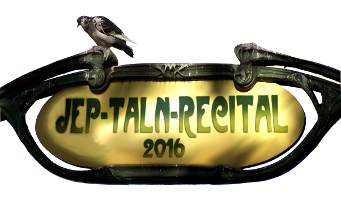JEP-TALN-RECITAL 2016, Paris, France
23ème Conférence sur le Traitement Automatique des Langues Naturelles
31ème Journées d’Études sur la Parole
18ème Rencontre des Étudiants Chercheurs en Informatique pour le Traitement Automatique des Langues
Inalco, Paris, 4-8 Juillet 2016
Conférenciers invités
Christian Chiarcos (Johann Wolfgang Goethe Universität Frankfurt a. M.) - Mardi 10h00-11h00 (CI1) - Président de session : Emmanuel Morin
Corpora and Linguistic Linked Open Data: Motivations, Applications, Limitations 
Linguistic Linked Open Data (LLOD) is a technology and a movement in
several disciplines working with language resources, including Natural
Language Processing, general linguistics, computational lexicography
and the localization industry. This talk describes basic principles of
Linguistic Linked Open Data and their application to linguistically
annotated corpora, it summarizes the current status of the Linguistic
Linked Open Data cloud and gives an overview over selected LLOD
vocabularies and their uses.
A resource constitutes Linguistic Linked Open Data if it is published
in accordance with the following principles:
- The dataset is relevant for linguistic research or NLP algorithms.
- The elements in the dataset should be uniquely identified by means of a URI.
- The URI should resolve, so users can access more information using web browsers.
- Resolving an LLOD resource should return results using web standards such as Resource Description Framework (RDF).
- Links to other resources should be included to help users discover new resources and provide semantics.
- Data should be openly licensed using licenses such as the Creative Commons licenses.
- Representation: Linked graphs are a more flexible representation format for linguistic data
- Interoperability: Common RDF models can easily be integrated
- Federation: Data from multiple sources can trivially be combined
- Ecosystem: Tools for RDF and linked data are widely available under open source licenses
- Expressivity: Existing vocabularies help express linguistic resources.
- Semantics: Common links express what you mean.
- Dynamicity: Web data can be continuously improved.
- representing highly interlinked corpora (e.g., multi-layer corpora, annotated parallel corpora),
- integrating corpora with lexical resources available from the web of data,
- facilitating annotation interoperability using terminology resources available from the web of data, and
- streamlining data manipulation processes in a modular and domain-independent fashion.
Mark Liberman (LDC & University of Pennsylvania) - Jeudi 16h30-17h30 (CI2) - Président de session : Guillaume Gravier
From Human Language Technology to Human Language Science 
Thirty years ago, in order to get past roadblocks in Machine
Translation and Automatic Speech Recognition, DARPA invented a new way
to organize and manage technological R&D: a ``common task'' is
defined by a formal quantitative evaluation metric and a body of
shared training data, and researchers join an open competition to
compare approaches. Over the past three decades, this method has
produced steadily improving technologies, with many practical
applications now possible. And Moore's law has created a sort of
digital shadow universe, which increasingly mirrors the real world in
flows and stores of bits, while the same improvements in digital
hardware and software make it increasingly easy to pull content out of
the these rivers and oceans of information.
It's natural to be excited about these technologies, where we can see an open road to rapid improvements beyond the current state of the art, and an explosion of near-term commercial applications. But there are some important opportunities in a less obvious direction. Several areas of scientific and humanistic research are being revolutionized by the application of Human Language Technology. At a minimum, orders of magnitude more data can be addressed with orders of magnitude less effort -- but this change also transforms old theoretical questions, and poses new ones. And eventually, new modes of research organization and funding are likely to emerge.
It's natural to be excited about these technologies, where we can see an open road to rapid improvements beyond the current state of the art, and an explosion of near-term commercial applications. But there are some important opportunities in a less obvious direction. Several areas of scientific and humanistic research are being revolutionized by the application of Human Language Technology. At a minimum, orders of magnitude more data can be addressed with orders of magnitude less effort -- but this change also transforms old theoretical questions, and poses new ones. And eventually, new modes of research organization and funding are likely to emerge.
